Overview
In the fast-paced world of healthcare, providers often grapple with emotional challenges and overwhelming administrative burdens. This article sheds light on the importance of effective medical chart notes, illustrating how structured documentation methods—such as SOAP, PIE, and Focus charting—can alleviate some of these pressures. By enhancing communication among healthcare providers, these methods not only improve patient care but also ease the administrative load, ultimately leading to better healthcare outcomes.
Have you ever felt the weight of documentation affecting your ability to provide the best care? By adopting structured documentation, you can streamline your processes and focus more on what truly matters: your patients. These methods serve as a bridge, connecting you with your colleagues and ensuring that everyone is on the same page, which can significantly enhance patient safety and satisfaction.
Imagine a world where administrative tasks no longer overshadow your commitment to patient care. Embracing these documentation strategies can transform your workflow, allowing you to devote more time to your patients and less to paperwork. Let’s work together towards a more efficient healthcare environment where you can thrive.
We encourage you to explore these methods further and consider how they might fit into your practice. By doing so, you can not only improve your documentation but also foster a more compassionate and effective healthcare system for everyone involved.
Introduction
In the intricate landscape of healthcare, effective documentation transcends mere bureaucracy; it stands as a cornerstone of quality patient care. As innovative technologies, such as AI-powered solutions from CosmaNeura, emerge, healthcare providers are presented with a unique opportunity to streamline their documentation processes. This not only enhances efficiency but also significantly improves patient outcomes. Yet, as the medical field navigates the complexities of integrating these advancements, a pressing question arises: how can practitioners reconcile the demands of accurate record-keeping with the essential need for compassionate patient interactions?
This article explores seven compelling examples of medical chart notes that embody best practices in documentation. By offering insights into these practices, we aim to transform the way healthcare professionals approach their vital role, fostering a more compassionate and efficient healthcare environment.
CosmaNeura: Streamline Medical Chart Notes with AI-Powered Documentation
In the demanding world of healthcare, providers often face overwhelming administrative burdens that can detract from their primary focus: patient care. CosmaNeura understands these emotional challenges and offers a compassionate solution. By utilizing advanced AI technology, it transforms the generation of [examples of medical chart notes](https://blog.cosmaneura.com/10-essential-medical-note-templates-for-efficient-documentation), effectively addressing the resistance to innovation commonly encountered in the medical field.
Imagine a scenario where healthcare providers can automate routine record-keeping tasks. This shift allows them to dedicate more time to their patients, enhancing the quality of care they provide. Not only does this change boost efficiency, but it also ensures that records are both precise and timely, aligning with Catholic ethical standards. CosmaNeura excels in real-time transcription and summarization of telehealth sessions, providing valuable examples of medical chart notes while drastically reducing the time spent on record-keeping.
Research indicates that individuals using AI writing tools experience significant reductions in their workload, facilitating improved interactions with clients. In fact, 81% of physicians believe that generative AI enhances patient-provider interactions. This reinforces the value of integrating AI into clinical workflows. As medical institutions increasingly prioritize AI for administrative efficiency, consider the impact: projections suggest that 72% of medical organizations in the EU are expected to implement AI for monitoring individuals.
CosmaNeura stands out by ensuring that its solutions not only enhance financial efficiency but also adhere to the moral imperatives of Catholic teachings. Ultimately, this approach leads to improved quality of care for individuals. Are you ready to embrace this innovative solution and transform your practice? Together, we can foster .
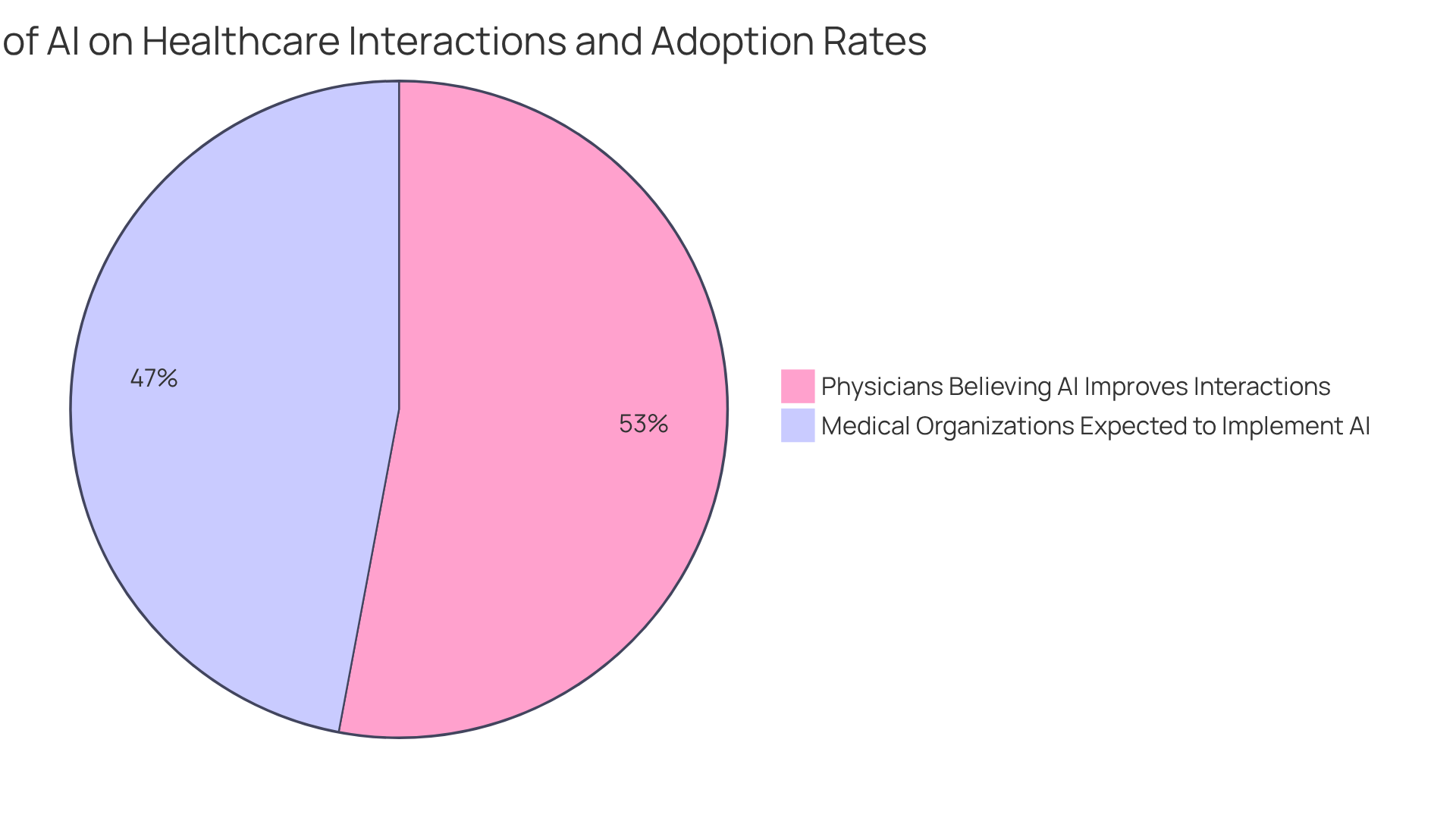
SOAP Notes: A Structured Approach to Patient Documentation
SOAP notes are essential examples of medical chart notes used in medical documentation, consisting of four key components: Subjective, Objective, Assessment, and Plan. This helps healthcare providers gather detailed individual information effectively. Have you ever felt overwhelmed by the amount of information to process? In the Subjective section, practitioners capture the individual's reported symptoms, offering valuable insights into their experience. Meanwhile, the Objective section focuses on measurable data, such as vital signs and lab results, providing a solid foundation for clinical assessments.
This approach not only simplifies clinical decision-making but also fosters better communication among medical teams. When everyone is aligned on care strategies, it enhances the overall quality of care provided. By using examples of medical chart notes such as SOAP notes, medical professionals can improve record quality, reduce transcription errors, and ultimately enhance outcomes for individuals. Imagine the difference this can make in your daily practice—supporting both you and your patients. Let's embrace this structured method together for a more compassionate approach to healthcare.
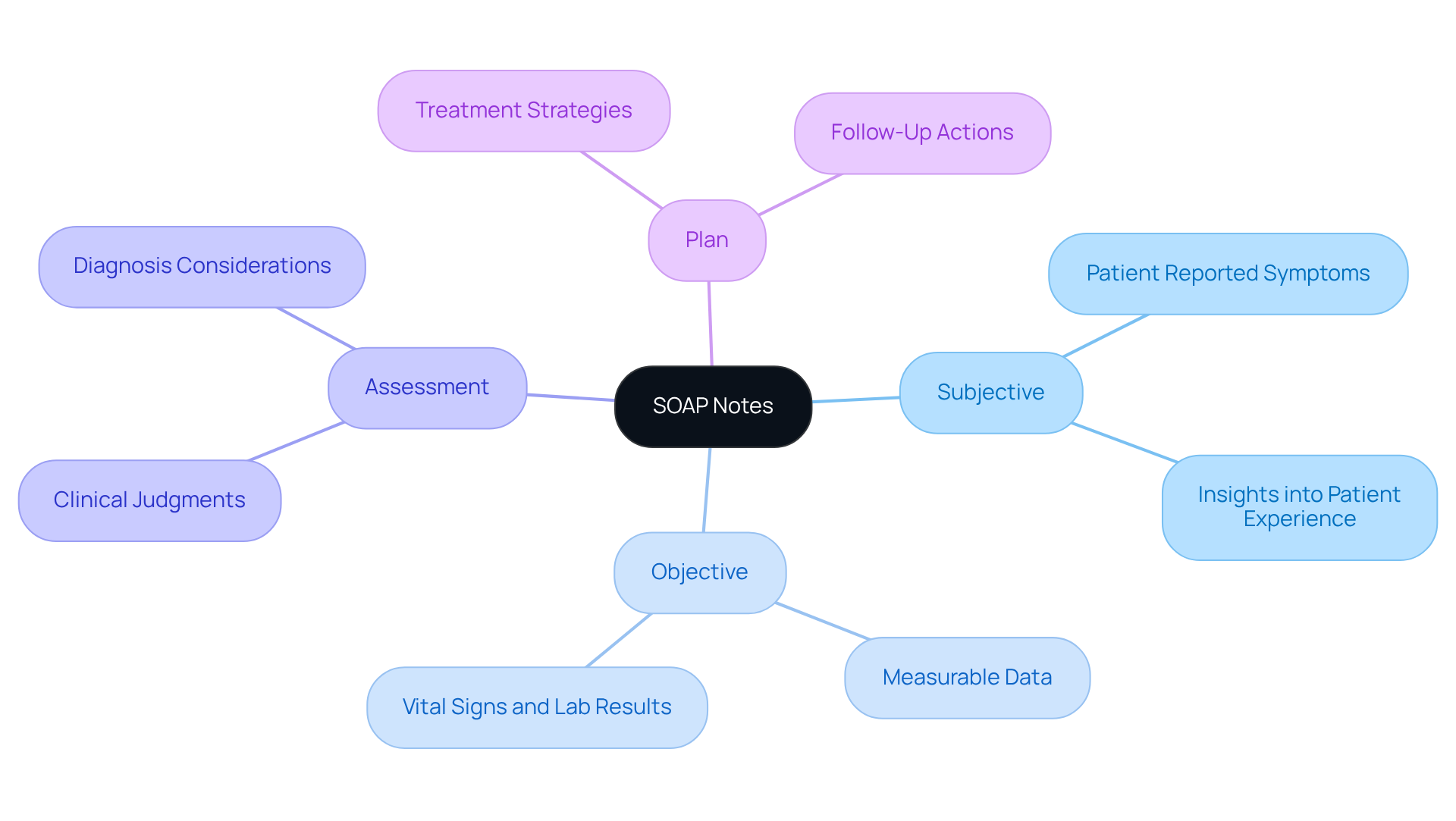
Narrative Notes: Capturing Detailed Patient Interactions
Healthcare providers often face emotional challenges that can impact their ability to deliver the best care. Narrative notes allow them to describe their interactions with individuals in detail, capturing the context and subtleties that structured formats may overlook. With the integration of CosmaNeura's Agentic Platform, these notes can be enhanced through , simplifying documentation and easing administrative tasks.
Imagine a narrative note that includes an individual's emotional state during a consultation. This insight is vital for understanding their overall health and well-being. By addressing issues such as physician burnout and resistance to innovation, we can foster a stronger bond between practitioners and individuals. This connection not only improves the quality of care but also makes it more efficient and accessible, supporting a client-centered approach.
Together, let's explore how we can enhance the healthcare experience for both providers and patients. By embracing these solutions, we can create a nurturing environment that prioritizes emotional health and strengthens the care provided.
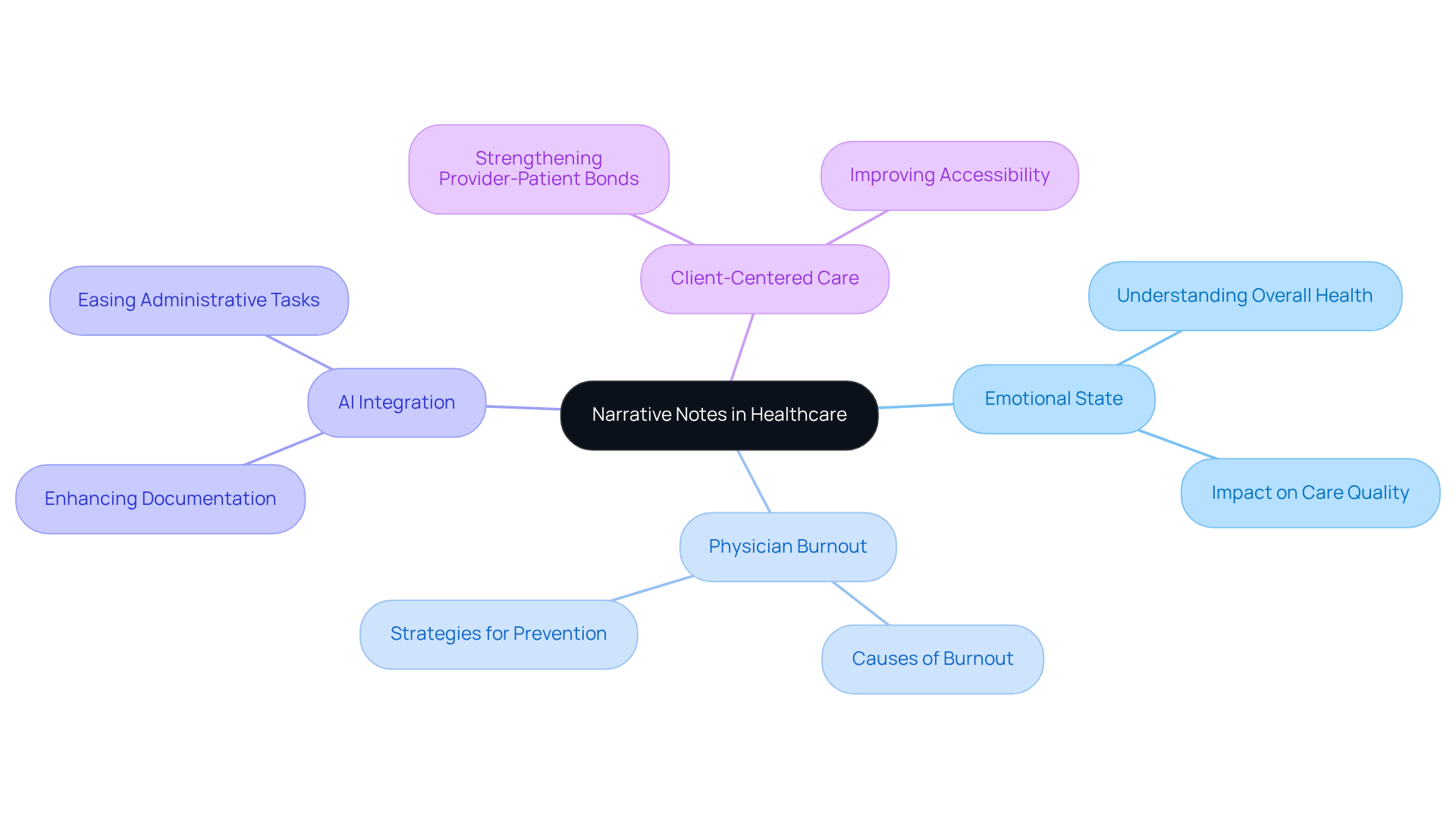
Charting by Exception: Efficient Documentation of Abnormal Findings
Charting by Exception (CBE) is a simplified recording technique that focuses on noting unusual results, significantly enhancing efficiency in medical environments. By omitting routine records for individuals whose vital signs and conditions are within normal limits, CBE allows providers to concentrate on significant deviations that require attention. This targeted approach not only reduces paperwork but also grants healthcare workers precious time for direct patient care.
Statistics reveal that hospitals implementing standardized documentation practices, including CBE, have experienced a 20% reduction in documentation errors, highlighting its effectiveness in improving accuracy and efficiency. Moreover, CBE can substantially decrease administrative workload, enabling nurses to reclaim several hours each day that were previously devoted to routine charting. This newfound efficiency not only boosts job satisfaction among providers but also enhances outcomes for patients by ensuring that critical information is recorded and addressed promptly.
However, it is crucial to maintain a balance, as an over-reliance on CBE may risk overlooking subtle changes in a patient's condition. While CBE simplifies medical documentation, it is vital for medical teams to remain vigilant and ensure are performed when necessary. Additionally, the medical field often exhibits resistance to innovation, which can impede the adoption of effective practices like CBE.
To overcome these challenges, consider the integration of CosmaNeura's innovative Agentic Platform. This platform provides medical professionals with generative AI tools that streamline the CBE process, alleviate administrative burdens, and enhance overall experiences for patients. Successful case studies illustrate how the Agentic Platform has been implemented to tackle these challenges, ultimately leading to improved efficiency and patient-centered care.
What if you could spend less time on paperwork and more time providing compassionate care? Embracing CBE and innovative solutions like the Agentic Platform can help make that a reality. Let’s work together to create a healthcare environment where both providers and patients thrive.
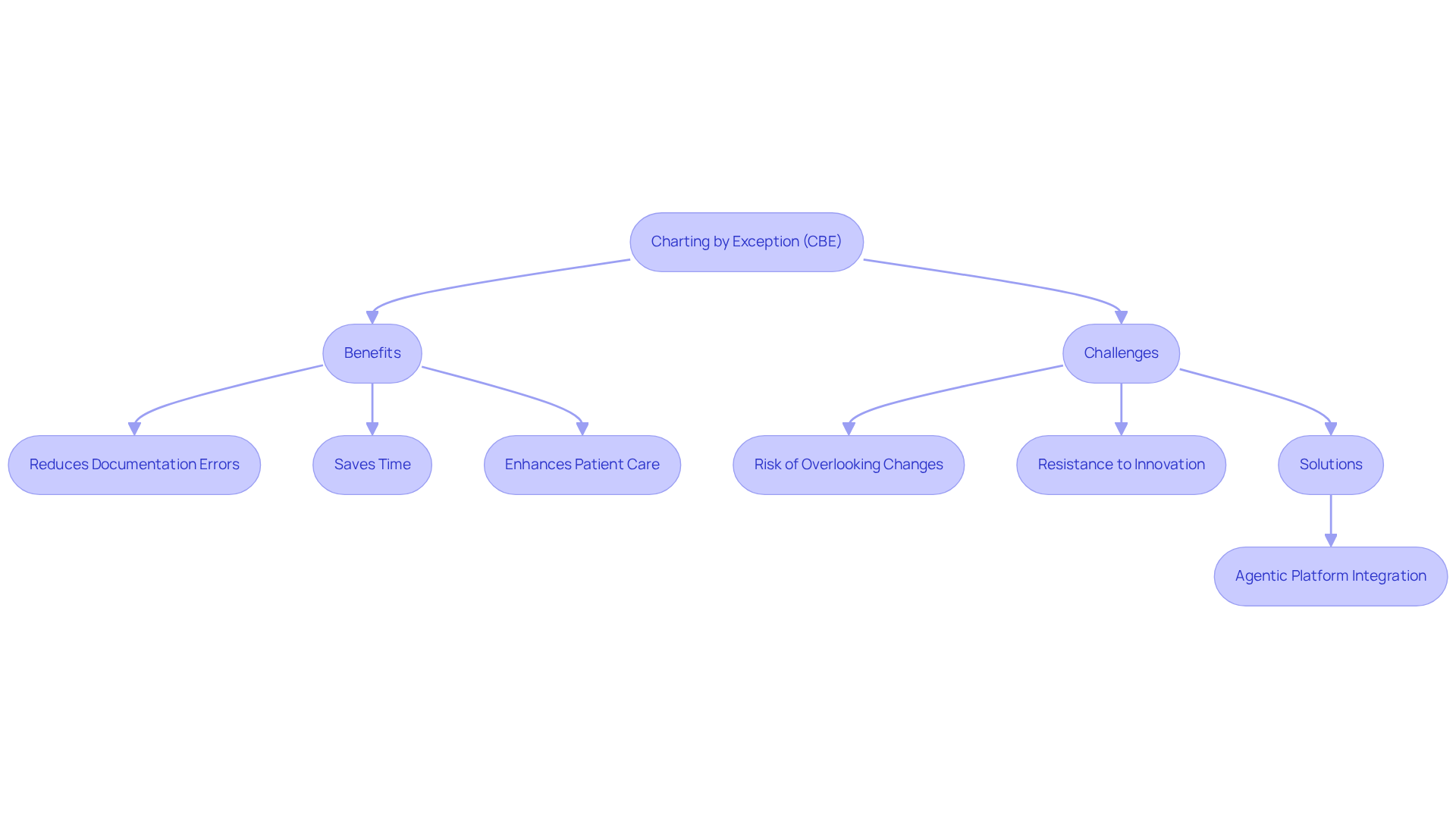
PIE Charting: Focused Documentation on Patient Problems and Interventions
In the demanding world of healthcare, professionals often face emotional challenges that can impact their ability to provide the best care. One effective method to alleviate some of these burdens is PIE charting, which stands for Problem, Intervention, and Evaluation. This structured documentation method significantly enhances care records, allowing medical professionals to clearly articulate individual concerns, the actions taken, and the outcomes achieved. For instance, if a patient reports discomfort, the healthcare provider would document the pain as the identified issue, detail the intervention—like administering medication—and evaluate the patient's response to that treatment.
The benefits of PIE charting are numerous and impactful. It promotes targeted record-keeping, ensuring that vital information about patients is captured succinctly, thereby improving communication among healthcare teams. Research indicates that organized documentation techniques, such as PIE charting, can lead to a remarkable 30% increase in documentation efficiency. This improvement allows caregivers to dedicate more time to patient care rather than administrative tasks.
Consider how PIE charting can be applied in real-life scenarios, such as addressing an individual’s nutritional needs. Here, the issue may be identified as inadequate dietary intake, the intervention could involve dietary counseling, and the evaluation would assess the progress in the individual’s nutritional status over time. This method not only fosters a deeper understanding of patient needs but also supports their overall well-being.
To successfully implement PIE charting, it is essential for medical professionals to begin by . Incorporating it into electronic health record systems and encouraging consistent use across all patient interactions will further enhance the quality of documentation. By adopting this structured approach, healthcare providers can align their practices with the best standards of patient-centered care, ultimately leading to improved outcomes for those they serve.
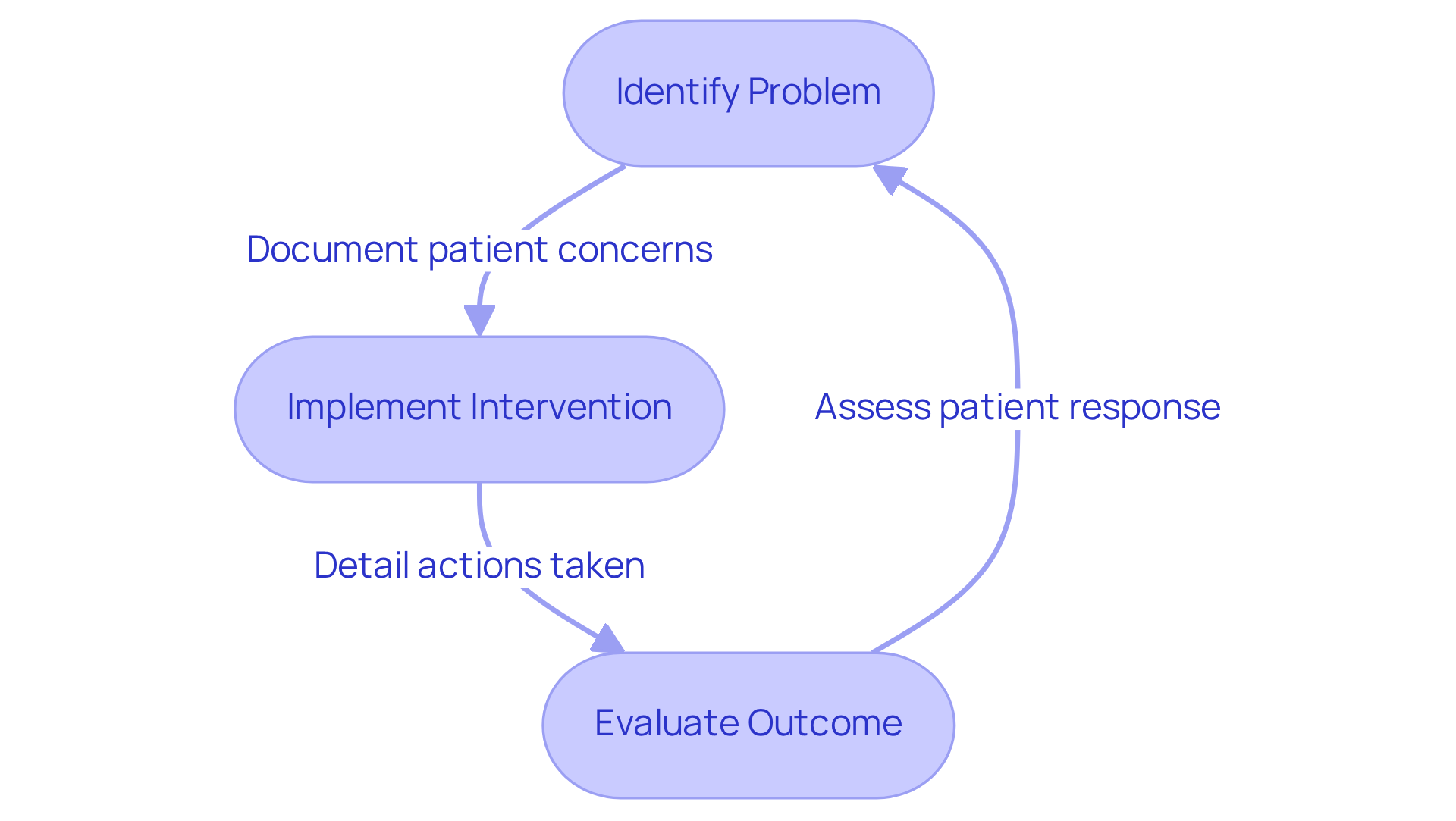
Focus (DAR) Charting: Targeted Documentation for Patient Care
In the demanding world of healthcare, providers often face emotional challenges that can impact their ability to deliver the best care. Focus charting, commonly known as DAR (Data, Action, Response), serves as examples of medical chart notes that provide a structured way to address these individual issues. The Data section captures essential information about the individual, while the Action section provides examples of medical chart notes that outline the interventions implemented. Meanwhile, the Response section records the individual's reaction to those interventions, which includes examples of medical chart notes to ensure a comprehensive understanding of their experience.
Imagine how incorporating groundbreaking AI solutions, like those provided by CosmaNeura's Agentic Platform, can ease the administrative burdens that often distract from patient care. By improving record-keeping efficiency and precision, this approach not only alleviates stress for healthcare providers but also enhances the overall quality of medical files. This means that records are succinct and directly connected to care, ultimately leading to better experiences for individuals.
As we reflect on these solutions, consider how they can transform your practice. By embracing focus charting and innovative technologies, we can foster a more compassionate healthcare environment, ensuring that every individual receives the attention they deserve. Together, let's explore how we can make a in our patients' lives.
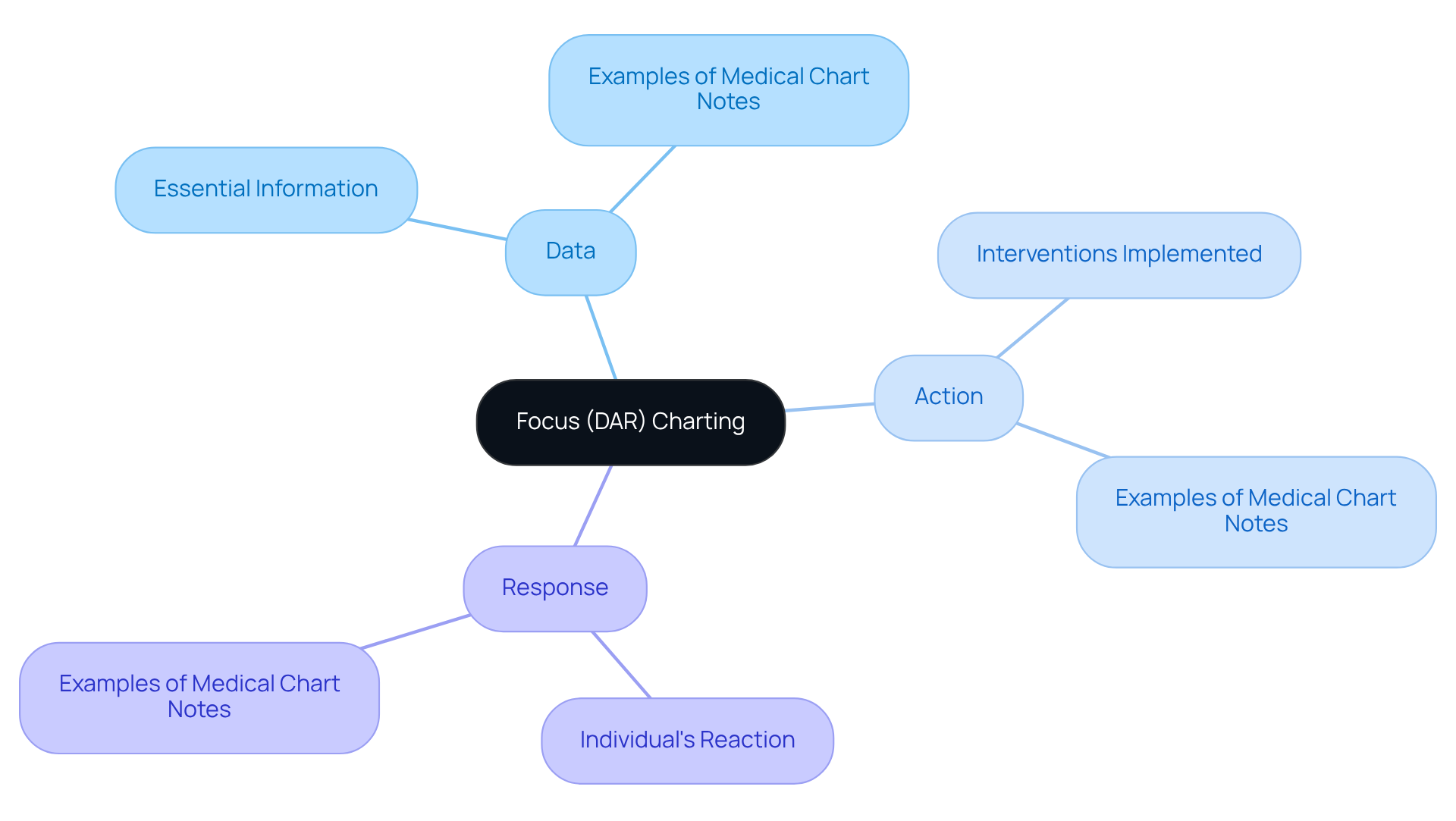
Electronic Health Records (EHR): Best Practices for Medical Chart Notes
Healthcare providers often face significant emotional challenges in their demanding roles. The associated with Electronic Health Records (EHR) can impact the quality of patient care, leaving many feeling overwhelmed. How can we alleviate this stress and enhance the quality of care?
Optimal methods for utilizing EHRs include:
- Ensuring data accuracy
- Maintaining the confidentiality of individuals
- Incorporating examples of medical chart notes for consistency
By documenting in real-time, providers can capture accurate information and reduce errors, ultimately improving the patient experience. Additionally, consistent training on EHR features can foster efficiency and guarantee adherence to record-keeping standards.
By embracing these optimal methods, medical professionals not only enhance the quality of their records but also create better examples of medical chart notes to improve the care they provide to individuals. Imagine the peace of mind that comes from knowing your records are accurate and secure. Let’s work together to support one another in navigating these challenges and enhancing our practices for the benefit of our patients.
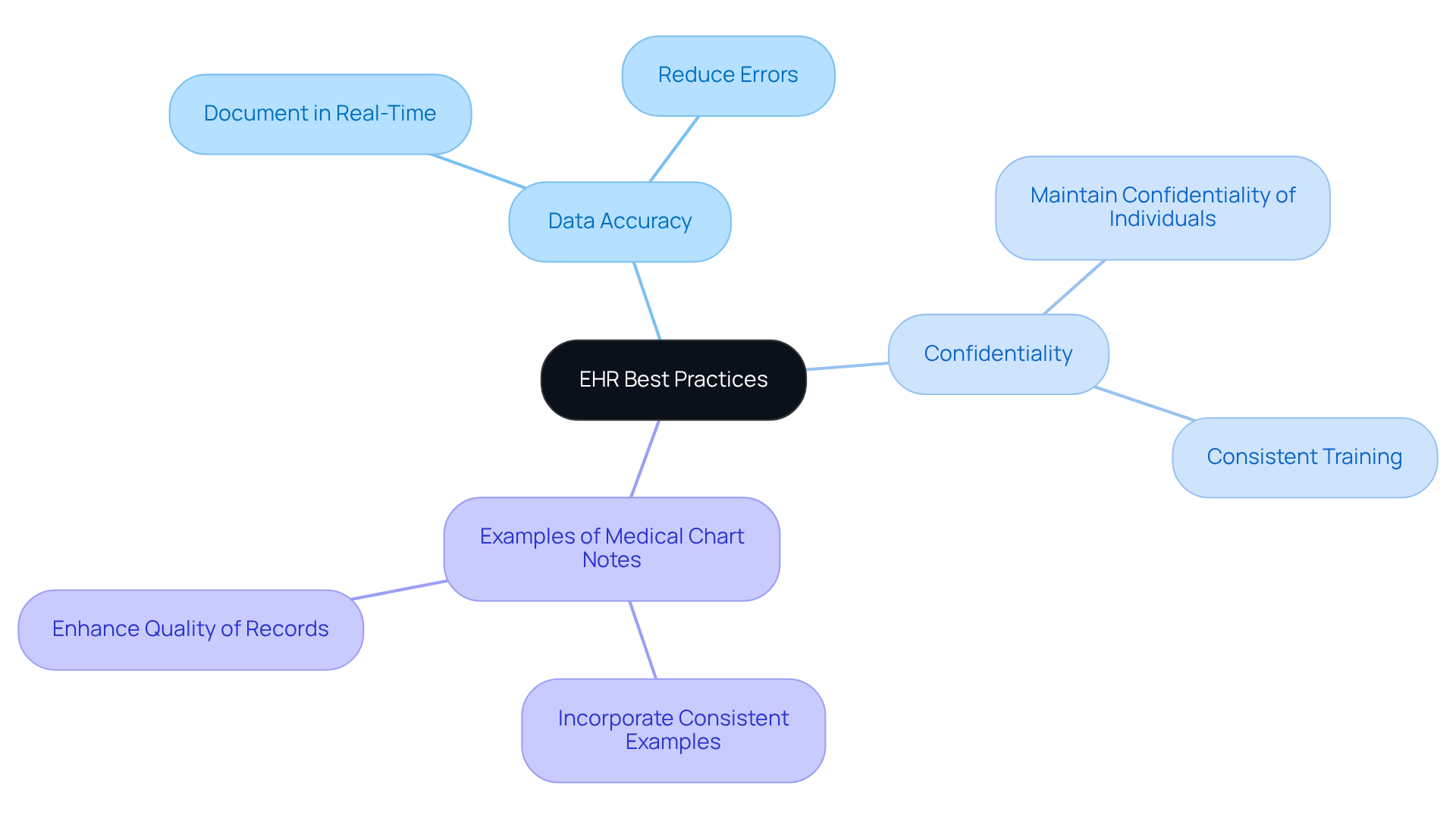
Documentation Dos and Don'ts: Ensuring Accuracy in Medical Charting
Precise medical records are essential for the efficient care of individuals, and it is vital for healthcare professionals to follow to uphold high standards.
Dos:
- Document all relevant patient information, including treatment dates, goals, and progress. Complete medical records are crucial for informed decision-making.
- Use clear and concise language to enhance understanding and reduce the risk of misinterpretation.
- Ensure that all entries are dated and signed, including the clinician's credentials, to maintain accountability and legal integrity as required by regulations.
- Engage in ongoing training and audits to improve documentation practices and ensure compliance with evolving standards.
Don'ts:
- Avoid vague language that can lead to confusion or miscommunication about a patient's condition.
- Do not exclude essential information, as this can jeopardize individual safety and care quality, potentially resulting in medical errors and legal responsibilities.
- Refrain from documenting for others; each entry should reflect the individual clinician's observations and assessments.
Following these guidelines not only preserves the integrity of medical records but also significantly influences patient care outcomes by promoting clear communication among medical teams. Have you considered how your documentation practices impact your patients? Additionally, healthcare providers should be aware of the ASHA Code of Ethics, which mandates accurate record-keeping and prohibits misrepresentation of services for reimbursement. Together, we can ensure that our documentation supports the best possible patient care.
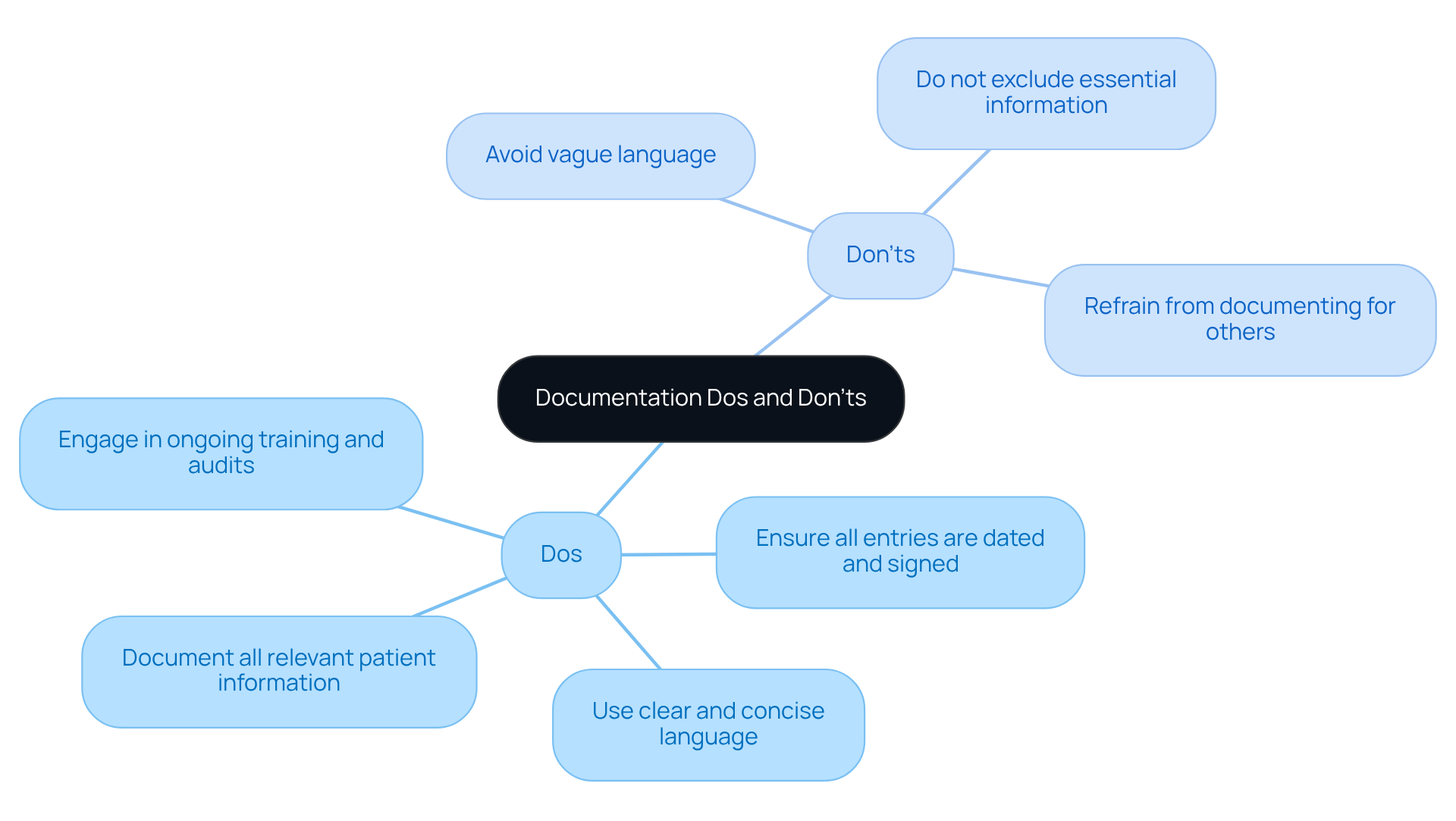
Patient Consent: Ethical Considerations in Medical Documentation
Obtaining informed consent is not just a procedural step; it’s a vital part of the compassionate care we provide. Have you ever considered how essential it is for individuals to truly understand the procedures and treatments they are agreeing to? This understanding is crucial, and it’s important that we document these discussions as examples of medical chart notes in the medical record. By doing so, we honor individual autonomy and ensure that consent is given willingly.
When we think about the , it becomes clear that appropriate record-keeping of consent serves a dual purpose. It not only protects the patient but also safeguards the practitioner legally. This practice helps to alleviate some of the administrative burdens that can often distract from the core of patient care. Let’s remember that our commitment to transparency and empathy can significantly enhance the trust in our relationships with those we serve.
In our roles as healthcare providers, we face many challenges, but by prioritizing informed consent, we can foster a more supportive environment. This approach not only benefits our patients but reinforces our professional integrity. How can we further engage in these crucial conversations? Let’s take the time to reflect on the importance of informed consent and ensure that every voice is heard and respected.
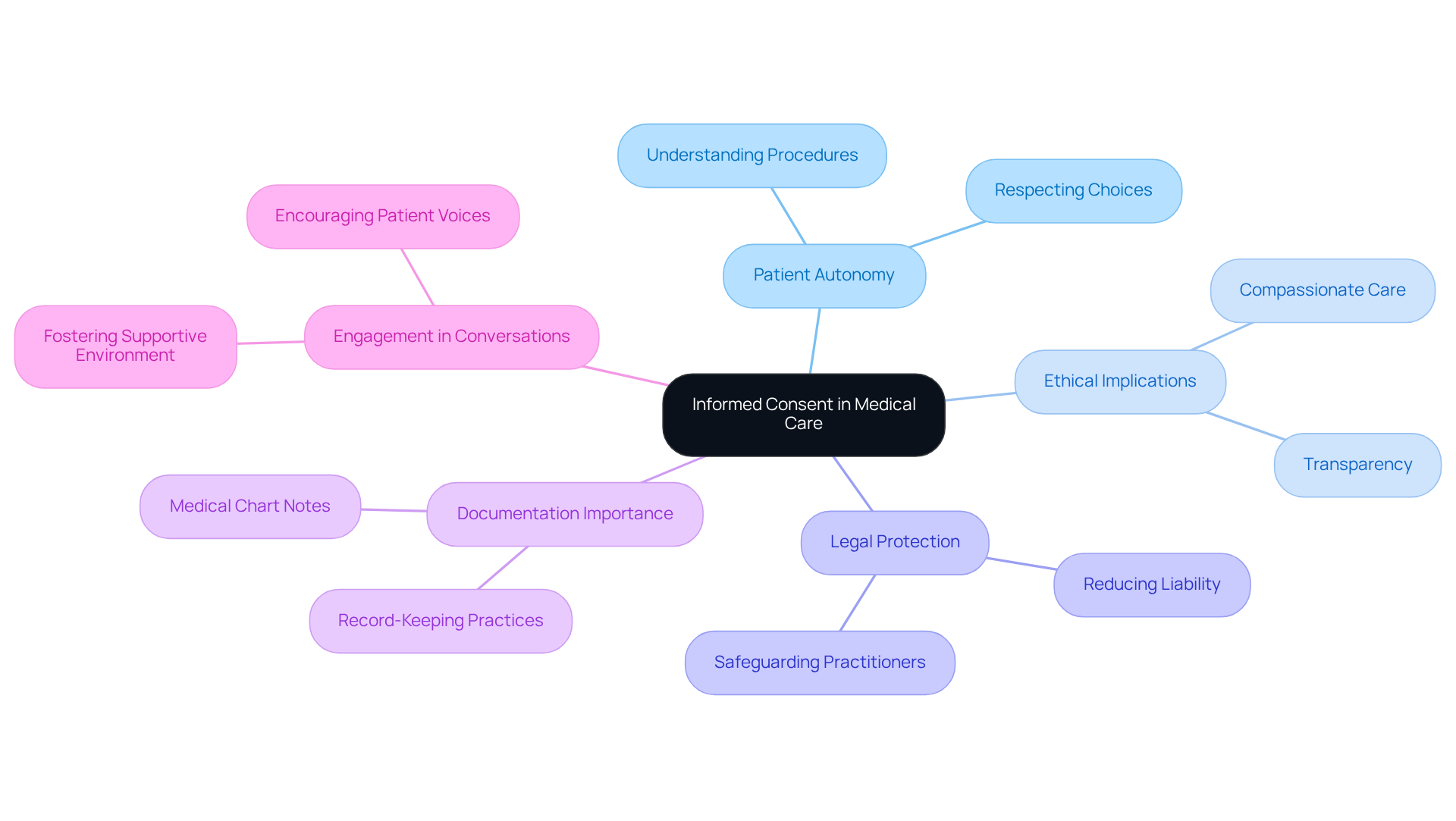
Continuous Education: Staying Updated on Medical Charting Practices
Healthcare professionals often face emotional challenges in their demanding roles. The burden of administrative tasks can weigh heavily, impacting the quality of patient care. By participating in ongoing education, you can stay informed about the latest recording methods and regulations. This may involve:
- Attending workshops
- Engaging in online courses
- Reviewing current literature on medical records
Investing in your education not only enhances your documentation skills but also ensures compliance with legal and ethical standards. Imagine the difference it can make in your practice—better documentation leads to improved patient care. When you feel confident in your skills, you can focus more on what truly matters: your patients.
So, why not take that next step? Consider exploring available resources that can support your growth. By prioritizing your education, you’re not just enhancing your expertise; you’re ultimately enriching the lives of those you care for. Together, let’s strive for .
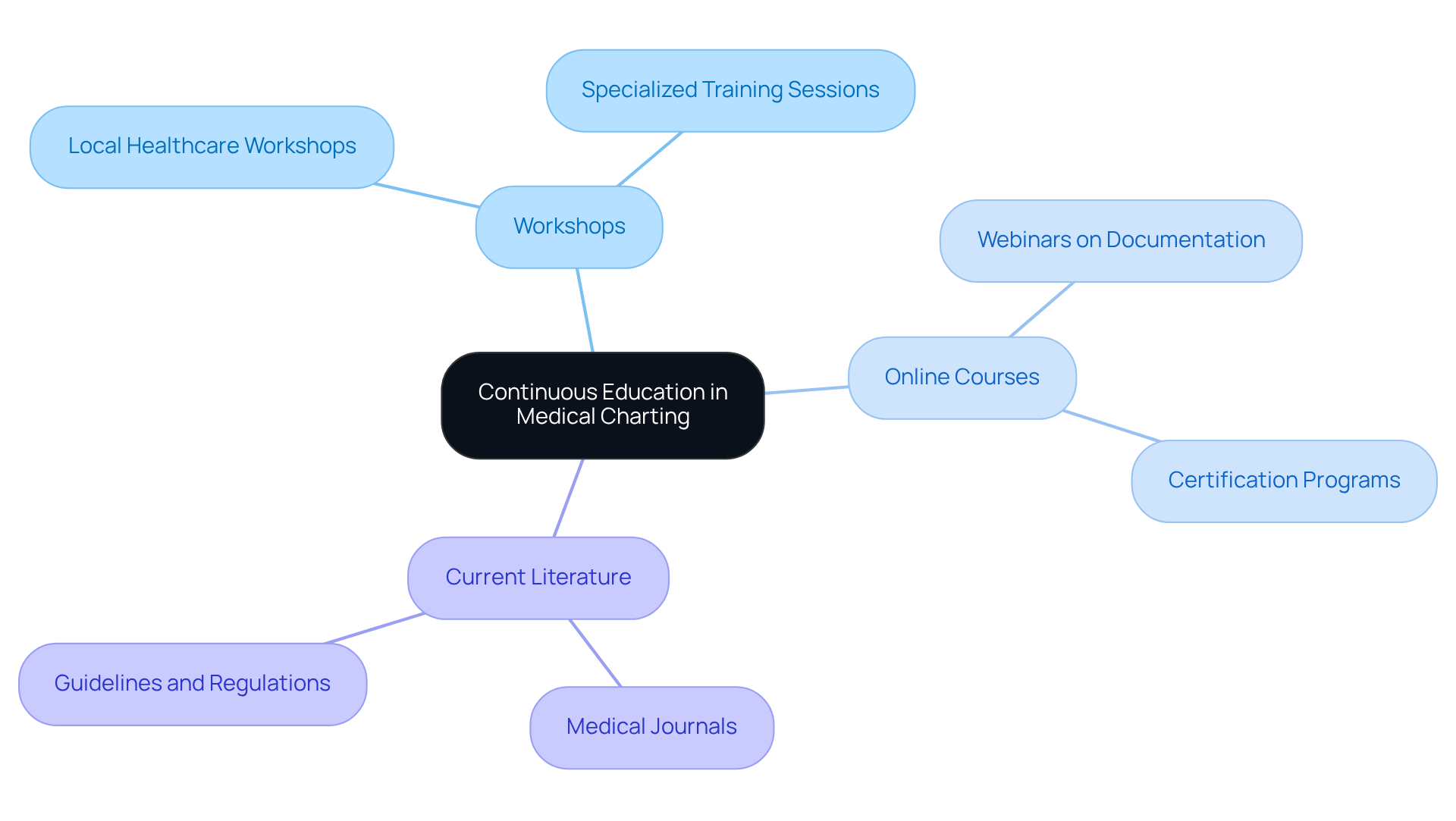
Conclusion
In the realm of healthcare, effective documentation is paramount for ensuring quality patient care and streamlining administrative processes. Many healthcare providers face emotional challenges due to overwhelming workloads. This article highlights various examples of medical chart notes, emphasizing structured formats like SOAP, narrative notes, and innovative approaches such as Charting by Exception and PIE charting. These methods not only enhance the accuracy and efficiency of medical records but also alleviate the emotional burdens faced by healthcare providers, allowing them to focus more on their patients.
Key insights from the discussion include the transformative role of AI-powered documentation solutions, like those offered by CosmaNeura. These solutions can significantly reduce the workload of healthcare professionals. Imagine how much easier communication among medical teams could be, ultimately enhancing the overall quality of care provided to individuals. Additionally, the article underscores the ethical considerations of patient consent and the necessity of continuous education in maintaining high standards in medical documentation.
Embracing these documentation practices and innovative tools is essential for fostering a compassionate healthcare environment. By prioritizing effective documentation, healthcare providers can meet both the clinical and emotional needs of their patients. A commitment to ongoing education and adherence to best practices will not only improve individual patient outcomes but also contribute to a more efficient and empathetic healthcare system.
It is time to take action and implement these strategies. Together, we can enhance the quality of care delivered to every patient.




